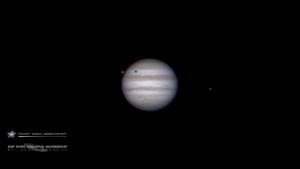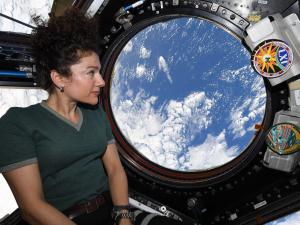Celebration of Space - September 10, 2021

Jupiter with the four Galilean Moons. Image credit: Frosty Drew Astronomy Team member, Scott MacNeill
Have you seen Jupiter’s four Galilean Moons in a telescope before? They are easily visible on the sides of Jupiter when observing with even a small telescope. Each of the four moons are unique in their own way and are some of the largest moons, as well as some of the largest bodies in the Solar System.
The closest of the four Galilean Moons to Jupiter is Io. Probably the most influential of the Galilean Moons, Io is the most geologically active solar system body. Littered with volcanoes, lava flows, and huge lava plumes, Io is at a constant state of unrest as it is pulled back and forth between Jupiter’s gravity and the gravity of Galilean Moons Europa and Ganymede. This constant tidal activity is what causes the intense volcanic activity.
Europa is the second Galilean Moon in distance from Jupiter, and is the smoothest known solid body in the Solar System. On the surface, Europa is a vast field of ice, which hides a liquid water ocean beneath. Europa shares a stable orbital resonance with Io, which puts Io at two full orbits around Jupiter for every one full orbit of Europa. The probability that Europa’s subsurface ocean is in contact with the mantle significantly increases the possibility for habitability. Making Europa one of the most likely places to find life outside of Earth.
Ganymede is the largest of all Galilean Moons, and the third Galilean moon from Jupiter. Ganymede is also the largest Moon in the Solar System and the overall 9th largest object in the Solar System, including the Sun. Ganymede has a stable independent magnetic field, a subsurface ocean with potentially more water than exists on Earth, and has a history of geological activity. Some regions on Ganymede's surface are quite young with little to no cratering, with other regions being ancient with dramatic impact scarring. Ganymede is part of the stable orbital resonance that exists between Europa and Io, with Io completing four full orbits for every one orbit of Ganymede, and Europa completing two full orbits.
The fourth and most distant of all Galilean Moons is the moon Callisto. Callisto resides at over 1 million miles distant from Jupiter, and is completely covered in impact craters. It is considered the most cratered object in the Solar System, and has a surface that clearly reveals a history of comet and asteroid impacts. Being excluded from the orbital resonance of the other three Galilean Moons, leaves Callisto’s interior quite cool, with multiple icy layers that stretch down to the moon’s core. There is quite likely a liquid water ocean stuck in between the ice layers. Callisto is a potential location for a future research outpost dedicated to studying the Jupiter system.
This weekend at Frosty Drew Observatory we will be hosting the live performance: Moons of Jupiter, which will go much further in depth about these fantastic solar system bodies.
Each night this weekend be sure to step outside about an hour after sunset to catch a view of the waxing crescent Moon moving, about 15° per night eastward from Venus to the bright star Antares. With September 12th being the night that the Moon and Antares are in conjunction. On that night, the Moon will be about 3° above the bright red star Antares in the constellation Scorpius. With beautiful weather on the schedule for this weekend, there are a few opportunities to catch a stunning view of the night sky. So step out and celebrate clear skies with a view of the Moon each night and catch the conjunction on the 12th.
This coming Tuesday, September 14th, the International Space Station (ISS) will return to the evening sky over the US, bringing daily passes of the space based residency in the evening hours after sunset. Seeing the ISS pass over is highly recommended as it is quite an enlightening experience. Evening passes are much more family friendly than early morning passes before sunrise, because everyone is usually home and still up. Here is a list of notable passes of the ISS for this week:
Wed, Sep 15 at 8:11 pm, starting in the SSW, rising to 35°, and into orbital sunset
Thu, Sep 16 at 7:25 om, starting in the S, rising to 21°, heading towards the E
Evening passes of the ISS will continue daily through the rest of September and into October, with the last evening pass of this cycle occurring on October 9th. The earlier sunset times of late summer and autumn, make it easy to get the family out for a view. For daily pass times of the ISS and other bright satellites, visit the Frosty Drew Daily Satellite Pass Prediction Utility.
This coming Tuesday, September 14, 2021 will bring Earth to the point in our orbit where we are directly in between the Sun and Neptune, placing Neptune on the other side of Earth than the Sun. We call this “opposition”, and it is the best time of the year to observe Neptune. Now, Neptune is really far away, at a distance of 2,688,005,402 miles from Earth on the date of opposition, which is its closest to us for the year, makes it difficult to observe. Neptune is also quite small, and is the smallest of all the gas giants. Naked eye visibility is totally out the window, so don’t even try. But in a moderately powered telescope, you can see the planet’s disk, as well as the blue hue that it casts. Over the next several weeks we will be attempting views of Neptune in the large telescope at Frosty Drew Observatory. Make plans to stop in and see the blue planet with your own eyes!
- Author:
- Scott MacNeill
- Entry Date:
- Sep 10, 2021
- Published Under:
- Scott MacNeill's Columns




